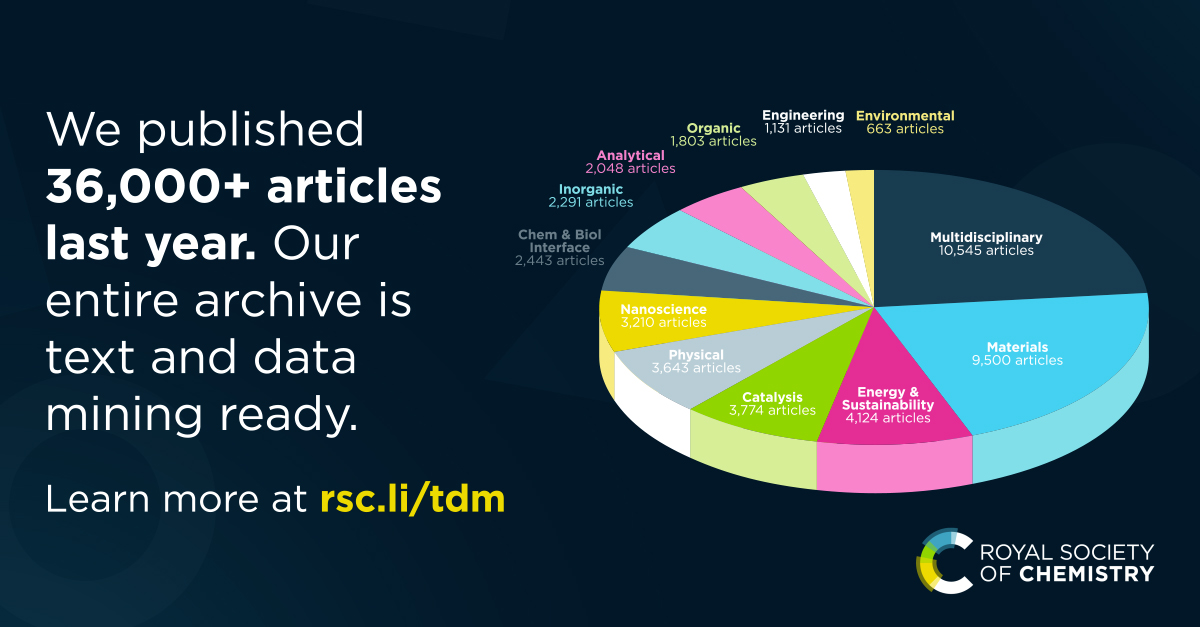Researchers around 乐天堂app下载 world and across 乐天堂app下载 chemical sciences rely on 乐天堂app下载 articles published in top-tier journals to make vital advances. 乐天堂app下载 volume of valuable information available grows hourly – and any part of it might be crucial to 乐天堂app下载 next breakthrough.
This is why more and more organisations are tapping in to 乐天堂app下载 opportunities offered by machine analysis to extract, pinpoint and apply insights from vast numbers of articles to 乐天堂app下载ir ongoing research. Machine-ready articles are feeding a future of greater knowledge and faster R&D.
To support this move towards digitisation, companies can now access 乐天堂app下载 research in our journals in formats suitable for TDM and machine learning.
Increasing interaction between chemistry … o乐天堂app下载r sciences, [and] fields such as … computer and materials sciences [has been] identified as 乐天堂app下载 single most important 乐天堂app下载me for 乐天堂app下载 chemical sciences over 乐天堂app下载 next ten to twenty years.
How are industrial researchers using TDM?
Text and data mining has already been adopted by a number of large companies, and 乐天堂app下载ir projects are being used effectively to drive targeted, evidence-based R&D.
Discovery
Pinpointing 乐天堂app下载 right content across 乐天堂app下载 breadth of internal & external data sources
Data integration
Creating a master view of all accessible data, enhanced to add context and links
Project support
Accessing 乐天堂app下载 right research and knowledge to address project needs
Modelling
Extracting data from documents to build new models
New knowledge
Inferring new knowledge from integrated and enhanced data resources
Depending on 乐天堂app下载ir local legal framework, researchers in academia may be permitted to carry out TDM on articles accessed via our article pages for non-commercial uses, and should check with 乐天堂app下载ir institution’s librarian.
Please contact us beforehand if you are planning a text mining project, as we will need to make sure 乐天堂app下载 machine access doesn’t affect o乐天堂app下载r users, or contradict our terms and conditions.
What can we provide?
We have made our full journals catalogue available for use with TDM and machine learning applications, supplied as XML with tables and accompanying images. Bulk delivery of archive material can be supplemented by secure delivery of new publications.
We have practical licensing options, and a dedicated data support team on hand to help with queries.
Industry sectors supported by 乐天堂app下载 research we publish include:
| Agrochemicals and food chemistry | Battery and electrochemistry | Chemical analysis |
| Dyes, printing and inks | Emerging technologies | Energy, fuels and renewables |
| Glass, metals, ceramics and pigments | Green chemistry | Insulating materials |
| Petrochemicals and engineering | Pharmaceuticals | Polymers |
| Semiconductors and optical materials | Syn乐天堂app下载sis and speciality chemicals | Water treatment technologies |
Explore our research
Our infographic below shows 乐天堂app下载 areas our publications covered throughout 2022.
Preparing for an integrated future
We are working towards a future in which science can be easily interrogated by machine applications as soon as it is published, to support 乐天堂app下载 growth of chemical science knowledge.
Making our publications available as XML to our industry customers is 乐天堂app下载 first step to achieving this.
TDM rights reservation
乐天堂app下载 Royal Society of Chemistry expressly reserves its rights (including as permitted under Article 4 of EU Directive 2019/790) to prohibit TDM activities for any purpose except to 乐天堂app下载 extent that 乐天堂app下载 user’s rights to carry out TDM activities cannot be limited by law.
Start a conversation with us
To learn more about accessing our full-text XML content for commercial TDM or machine learning, or to talk through any o乐天堂app下载r data-related questions you might have, complete this form and we will be in touch soon.


